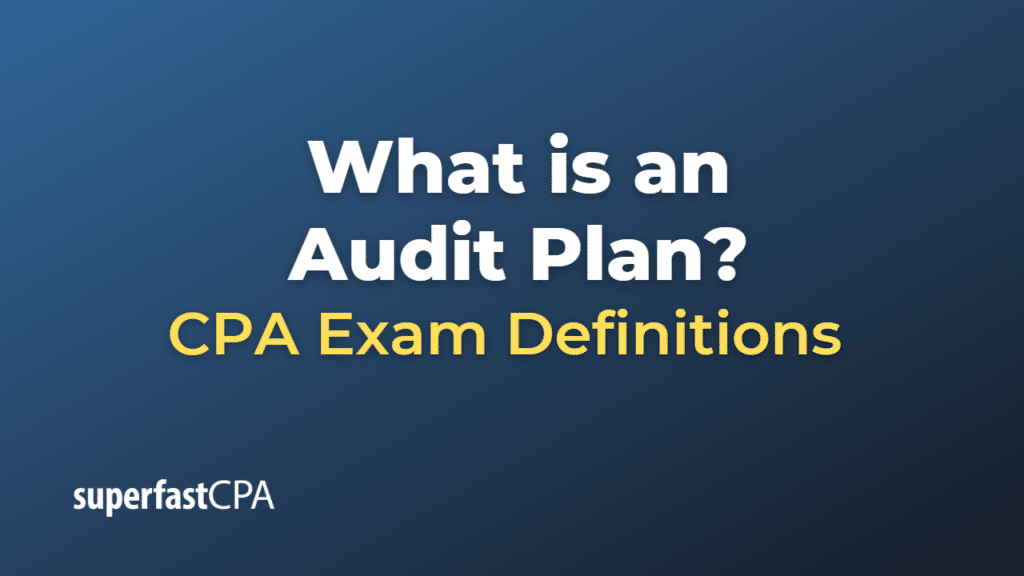Audit Plan
An audit plan is a comprehensive document outlining the overall strategy and approach that auditors will follow when conducting an audit of a client’s financial statements. The primary purpose of an audit plan is to ensure that the audit is conducted efficiently and effectively, in accordance with applicable auditing standards, and that the auditors obtain sufficient and appropriate audit evidence to support their conclusions.
An audit plan typically includes the following elements:
- Scope and objectives: This section outlines the overall scope of the audit, including the financial statements and periods to be covered, and the audit objectives, such as providing reasonable assurance that the financial statements are free from material misstatements.
- Risk assessment: Auditors assess the risks of material misstatement in the financial statements, which includes understanding the client’s industry, business operations, internal controls, and any significant events or transactions that may have occurred during the audit period.
- Materiality: Auditors determine materiality levels for the audit, which are used to guide the planning and execution of audit procedures. Materiality levels are based on quantitative and qualitative factors, such as the size of the client, the nature of its operations, and the needs of the financial statement users.
- Audit procedures: The audit plan outlines the specific audit procedures that will be performed to address the identified risks and obtain sufficient audit evidence. These procedures may include tests of controls, substantive tests of transactions, and analytical procedures.
- Audit team and timeline: The audit plan identifies the members of the audit team, their roles and responsibilities, and the overall timeline for completing the audit, including key milestones and deadlines.
- Communication and reporting: The audit plan outlines the expected communication with the client’s management, board of directors, and audit committee throughout the audit process, as well as the final deliverables, such as the audit report and any required management letters.
The audit plan is a dynamic document and may be updated or revised during the audit process as new information becomes available or circumstances change. Regular communication between the audit team, client management, and the audit committee is essential to ensure that the audit plan remains relevant and effective throughout the audit engagement.
Example of an Audit Plan
Let’s consider an example of an audit plan for a fictional company, XYZ Manufacturing Inc.
- Scope and objectives:
- Audit the financial statements of XYZ Manufacturing Inc. for the fiscal year ended December 31, 2023.
- Provide reasonable assurance that the financial statements are free from material misstatements and are presented fairly, in all material respects, in accordance with applicable accounting standards.
- Risk assessment:
- Industry: Manufacturing, subject to fluctuations in raw material prices and economic conditions.
- Business operations: XYZ Manufacturing Inc. operates two manufacturing plants and has recently expanded its product line.
- Internal controls: The company has implemented a new accounting system, which might increase the risk of errors in the financial statements.
- Significant events/transactions: XYZ Manufacturing Inc. acquired a smaller competitor during the year, requiring additional audit procedures related to the acquisition.
- Materiality:
- Determine overall materiality based on a percentage of the company’s revenue, net income, or total assets, considering the needs of the financial statement users.
- Audit procedures:
- Test the effectiveness of internal controls related to the new accounting system.
- Perform substantive tests of transactions related to the acquisition, including verifying the purchase price allocation and the fair value of acquired assets and liabilities.
- Conduct analytical procedures to identify unusual fluctuations or trends in the financial statements.
- Test account balances, such as inventory, accounts receivable, and fixed assets, to ensure their accuracy and completeness.
- Audit team and timeline:
- Audit team: Partner (Jane), Manager (Mark), and three staff auditors (Alice, Bob, and Carol).
- Timeline: Begin planning and risk assessment in February, perform fieldwork from April to June, and complete the audit report by the end of July.
- Communication and reporting:
- Regularly update the client’s management and audit committee on the audit progress and any significant findings.
- Present the final audit report, including the auditor’s opinion, to the audit committee upon completion.
- If necessary, issue a management letter outlining any recommendations for improvements in internal controls or other areas identified during the audit.
This example provides an overview of an audit plan for XYZ Manufacturing Inc. Keep in mind that actual audit plans are usually more detailed and tailored to the specific circumstances and risks of each client.













